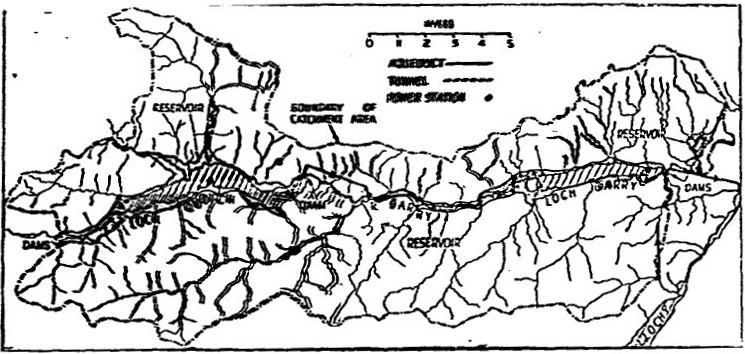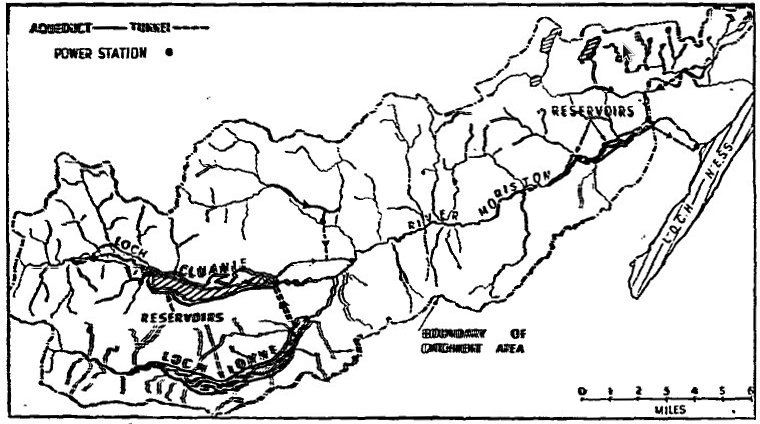Hydro Scheme Plans
The Scotsman, May 15, 1948.
TWO MORE HYDRO-ELECTRIC SCHEMES £13,000,000 Inverness-shire Projects Details of two schemes to utilise the water-power resources of Glen Garry and Glen Moriston in Inverness-shire for the production of about 384,000,000 units of electricity a year, are published to-day by the North of Scotland Hydro-Electric Board.They cover an area of 309 square miles north-west of the Great Glen and they will provide power for future industrial development in the Inverness-Fort William areas and increase the electricity available in the Highlands and other parts of Scotland. It is the board's intention to make electricity available to Fort Augustus and to the townships and many of the isolated houses in the Great Glen and Glen Garry and Glen Moriston.

The Board's projects differ considerably from the previous schemes - there were four between 1923 and 1938 - and take into account the objections raised in the past. The Garry project (Constructional Scheme No. 24) for example, differs from the earlier private promotions in two main respects:-
1. It is proposed to develop the water of Loch Quoich to the east, its natural course, and not to Loch Hourn on the West Coast.
2. The amounts of compensation water proposed are greatly in excess of those of previous Bills and the Board are prepared to construct and operate a fish hatchery. Consequently, it is hoped to preserve the stock of fish in the River Garry which is regarded as being one of the chief spawning rivers for the Moray Firth salmon fisheries.
The Garry scheme is estimated to cost £4,850,000 and will utilise a catchment area of 151 square miles to produce an average annual output of 170 million units. On the Garry there will be two main dams and two power stations and a subsidiary development centred on Loch Lundie.
At the eastern end of Loch Quoich a dam 806 feet long and 107 feet high, will be built across the Gearr Garry. From this storage reservoir, the water will be led to a generating station of 20,000 kilowatts, discharging into Loch Poulary, on the River Garry.
At the eastern end of Loch Garry there will be a dam 1026 feet long and 84 feet high. From there the water will be conveyed to Invergarry power station on the north bank of the River Garry near its outlet into Loch Oich in the Great Glen. This station will operate under a maximum head of 218 feet and have plant capacity of 20,000 kilowatts.

The Moriston project (Construction Scheme No. 23) will utilise the water-power resources of 153 square miles of catchment, most of which is in Inverness-shire and the remainder in Ross-shire for the production of about 214 million units of electricity a year. At present prices, the total estimated cost of this scheme is £8,000,000.
To develop the power resources of the Moriston with Loch Cluanie and Loch Loyne, four dams and four generating stations, with a total installed capacity of about 56,000 kilowatts will be built.
Loch Loyne, which lies to the south of Loch Cluanie at the head of the River Moriston, will be raised by a dam, 1542 feet long and 61 feet high and the water so impounded will be conveyed by tunnel and pipeline to Loch Cluanie.
Loch Cluanie will be raised by a dam, 2015 feet long and 103 feet high. From this loch, water will be led by a tunnel and pipeline to a 17,500 kilowatt power station near Ceannacroc Bridge.
A subsidiary power station, to utilise the waters of the upper catchment of the River Doe, will be built to the north of the Ceannacroc station. The water discharged from this station on the Doe will be led into the tunnel between Cluanie and Ceannacroc and utilised again in the Ceannacroc power station.
On the lower reaches of the River Moriston two dams will be constructed, one near Dundreggan, 367 feet long and 34 feet high, and the other to be called the Moriston Dam, 58 feet long and 95 feet high about two miles upstream from Invermoriston.
The Dundreggan dam will serve a power station of 13,000 kilowatt capacity close at hand on the upper reaches of the loch formed by the Moriston dam. Thereafter a tunnel and pipeline will convey water from the Moriston dam to the 20,000 kilowatt Invermoriston power station. Another subsidiary generating station will be situated at Livishie, near the Moriston dam, to utilise the water from a number of streams which at present flow into the River Moriston and Loch Ness. The Garry project will involve little damage to agriculture, and in Glen Moriston, where there is some cultivated ground, agricultural damage will be kept to a minimum by reducing the levels of the Dundreggan and Moriston reservoirs so as to flood much less land than was proposed in earlier schemes.
The fluctuation of most of the reservoirs will be reduced to a minimum. In the Garry scheme the main storage will be in Loch Quoich, Loch Garry being maintained near its top-water level except in emergency. The present natural fluctuation of Loch Garry is considerable and it is not expected that the fluctuation under the scheme will be as great.
In the Moriston scheme, the maximum use of Loch Loyne will reduce the fluctuation of the other reservoirs to a minimum and it is only in prolonged dry spells, particularly in winter, that Loch Cluanie will have to be drawn down.
Considerable permanent employment will be provided by the schemes. A village will be built at Invermoriston where it is understood that houses are also to be built by the Forestry Commission.
BOARD'S DISCUSSIONS WITH LOCAL INTERESTS
Members and officials of the North of Scotland Hydro-Electric Board held a series of meetings yesterday to discuss with various interests matters connected with their schemes. In the morning they met proprietors of land and fishings in the Great Glen (where the schemes for Glen Moriston and Glen Garry are to be carried out); in the afternoon representatives of Inverness county Council and the Ness District Fishery Board; and in the evening Inverness Town Council.
Mr Thomas Johnston, chairman of the Hydro-Electric Board presided, and he was accompanied by Mr A. E. MacColl, deputy chairman; Sir Hugh Mackenzie; Lord Provost Powrie, Dundee; Mr Neil Beaton; Provost MacGlashan, Convener of Perth-shire; Mr J. Erskine; Mr T. Lawrie, general manager of the board; and Sir William Halcrow, consulting engineer. At the conferences which were held in private, details of the schemes were given, and such points as the effect of the board's proposals upon agricultural land, river and loch fishing, road works, and the flow of water in the Rivers Garry, Moriston, and Ness were discussed. Further meetings are to be held between the board and various other bodies.